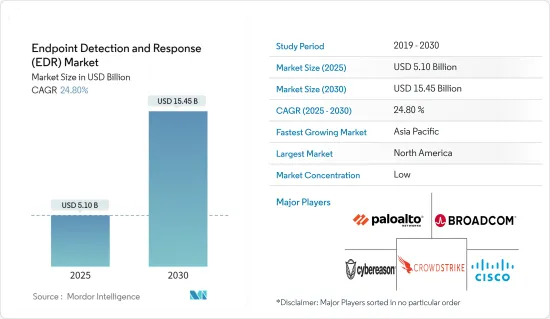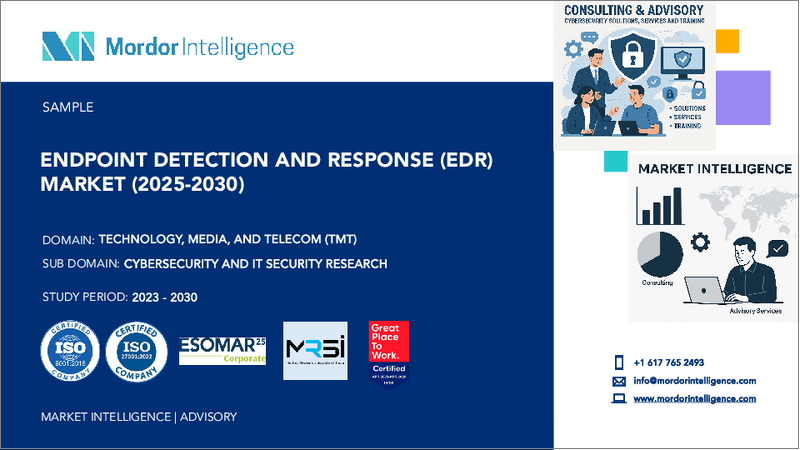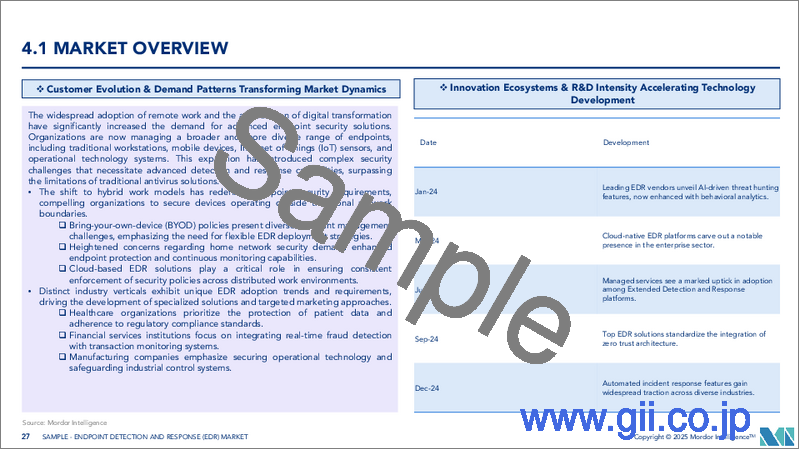|
|
市場調査レポート
商品コード
1687452
EDR(エンドポイント検知および対応):市場シェア分析、産業動向・統計、成長予測(2025年~2030年)Endpoint Detection and Response (EDR) - Market Share Analysis, Industry Trends & Statistics, Growth Forecasts (2025 - 2030) |
||||||
カスタマイズ可能
適宜更新あり
|
|||||||
| EDR(エンドポイント検知および対応):市場シェア分析、産業動向・統計、成長予測(2025年~2030年) |
|
出版日: 2025年03月18日
発行: Mordor Intelligence
ページ情報: 英文 140 Pages
納期: 2~3営業日
|
全表示
- 概要
- 目次
EDR(エンドポイント検知および対応)市場規模は、2025年に51億米ドルと推定・予測され、予測期間中(2025~2030年)のCAGRは24.8%で、2030年には154億5,000万米ドルに達すると予測されます。

主なハイライト
- 成長とともにデータ集約的なアプローチや意思決定の採用が増加している主な要因には、デジタル化の進展に伴う世界のサイバー攻撃件数の増加があります。世界のデータ侵害の増加により、企業はより分散化されたエッジベースのセキュリティ技術を採用するようになっています。これが、EDR(エンドポイント検知および対応)ソリューションの需要を促進しています。
- この成長は主に、エンドポイントデバイスの急激な増加、エンドポイント攻撃と侵害の継続的な増加と高度化、エンドポイント攻撃と戦うための高セキュリティソリューションへの比例した需要の増加によるものです。さらに、セキュリティ・エンドポイント市場の成長は、IoT、Al、ML、ビッグデータなどの革新的技術の登場や、急速に変化する法的枠組みによって複雑化する規制環境におけるITリスクの軽減などの要因によって支えられています。
- エンタープライズ・モビリティとは、従業員がさまざまなデバイスやアプリケーションを使用してどこからでも仕事ができるようにするアプローチです。これらのデバイスは、さまざまな方法で企業のセキュリティ・インフラに適合させることができます。主に、インダストリー4.0、機械間通信、スマートシティの出現による自動化の導入が急速に進んでいるため、エンドポイント数は2桁の伸びを示しています。
- 組織におけるBYOD動向の採用の増加により、さまざまなラップトップ、デスクトップ、スマートフォンが流入するようになり、攻撃に対して脆弱なさまざまなエンドポイントが発生しています。セキュリティ対策だけでは、攻撃を阻止するには十分ではありません。世界中でモバイル・デバイスの導入が大幅に増加しているため、予測期間中に大きなビジネスチャンスが生まれると期待されています。
- 顧客は、EDR(エンドポイント検知および対応)に多層的なアプローチを必要としており、優れた性能と低コスト、集中管理を組み合わせたツールを組み込んでいます。また、すべてのエンドポイントに脅威保護を提供し、物理環境、仮想環境、またはハイブリッド環境において顧客データの安全を確保するのに役立ちます。
EDR(エンドポイント検知および対応)市場の動向
中小企業が大きな成長を遂げる
- 中小企業は世界のGDP成長にとって不可欠な存在です。例えば、欧州委員会によると、2023年の欧州連合(EU)には約2,440万社の中小企業(SME)が存在すると推定されています。欧州経済における中小企業の貢献中小企業(SME)は欧州経済の屋台骨を形成しています。中小企業を狙ったサイバー攻撃はますます巧妙化しており、従来のエンドポイント保護メカニズムでは容易に防ぐことができないです。このような場合、潜在的な悪影響を最小限に抑えるためには、インシデントをタイムリーに検知することが不可欠です。
- 新たなデータ・ストレージを構築・維持する代わりにデータをクラウドに移行することで、コストとリソースを節約することの重要性に対する企業の意識が高まっていることから、クラウドベースのソリューションに対する需要が高まり、その結果、クラウドベースのEDR(エンドポイント検知および対応)ソリューションの採用が進んでいます。こうした利点から、世界中の中小企業や大企業がクラウドベースのソリューションを採用するケースが増えています。
- さらに、中小企業の需要増に対応するための技術革新の進展が、市場成長率を押し上げるとみられています。例えば、2024年2月、サイバーセキュリティのプレーヤーであるESETは、中小企業が直面するサイバーセキュリティの課題増大に対応する革新的なソリューションであるESET MDRの発売を発表しました。この新サービスは、ESETの企業向けサービス「Detection and Response Ultimate」を拡張することで、中小企業がインシデントに即座に対応し、セキュリティ体制を強化し、誤検知を減らし、脅威の検知、調査、対応能力を強化することを可能にします。
- ESET MDRは、AIを活用した自動化と人間の専門知識、包括的な脅威インテリジェンスの知識を組み合わせることで、比類のない脅威の検知とインシデント対応を実現します。また、24時間365日のセキュリティサービスを利用することで、専門知識のギャップを埋め、社内のセキュリティチームにかかるプレッシャーを軽減することができるため、中小企業は戦略的な取り組みに集中することができます。
アジア太平洋地域が最速の成長を記録する見込み
- 中国では、スマート製造工場の成長に支えられ、接続デバイスの数が増加し、さまざまな産業でモノのインターネット(Internet of Things)技術が採用されているため、エンドポイント・サイバーに強いビジネス環境を組織に提供するエンドポイント検知・対応サービスの成長に拍車がかかると予想されます。
- さらに、企業におけるデジタルトランスフォーメーションやクラウドの導入などの技術的進歩が、同国におけるサイバー攻撃のリスクに拍車をかけています。低コストの労働力確保に支えられた同国の製造施設の成長は、業界情勢におけるコンピュータとM2M通信の成長に拍車をかけており、ランサムウェアやマルウェアによるサイバー攻撃の脆弱性を高め、市場の需要を牽引しています。
- 日本では、デジタルツイン、センサー、顧客関係、ERPソフトウェアなど、クラウドベースのソリューションの産業分野への導入が大幅に進んでおり、コンピュータシステムとデータストレージサーバー要件の成長を支えています。
- インドのEDR市場は、企業における新興EDRソリューションの需要をサポートするために、新興企業の資金調達において著しい開発を記録しています。これは、将来の需要に対応するために市場の供給側を強化することで、市場の成長を促進すると思われます。
EDR(エンドポイント検知および対応)市場の概要
EDR(エンドポイント検知および対応)市場は、プレーヤー数の増加により断片化しています。大企業にとって、この目まぐるしく変化する世界で個人データを安全に保管することは最も重要な課題となっています。Palo Alto Networks Inc.、Cisco Systems Inc.、CrowdStrike Inc.、Broadcom Inc.、Cybereason Inc.などの大手企業は、こうした組織に対応するEDRツールを開発しています。
- 2023年12月ビジネスソフトウェアとサービスのレビュープロバイダーであるG2は、2024年冬レポートにおいて、ソフォスをエンドポイントプロテクション、EDR、XDR、ファイアウォール、MDRの重要なプレーヤーに選出しました。
- 2023年9月Cybereason Inc.は、2023年4月23日に資金調達ラウンドの拡大に成功し、ラウンド総額が1億2,000万米ドルに達したと発表しました。この資金調達により、同社は世界な事業規模を拡大し、予防、検知、レスポンスの分野における地位を強化します。
その他の特典
- エクセル形式の市場予測(ME)シート
- 3ヶ月間のアナリスト・サポート
目次
第1章 イントロダクション
- 調査の前提条件と市場定義
- 調査範囲
第2章 調査手法
第3章 エグゼクティブサマリー
第4章 市場洞察
- 市場概要
- 業界の魅力度-ポーターのファイブフォース分析
- 供給企業の交渉力
- 買い手の交渉力
- 新規参入業者の脅威
- 代替品の脅威
- 競合の程度
- 業界バリューチェーン分析
- COVID-19の市場への影響
第5章 市場力学
- 市場促進要因
- 企業モビリティの拡大
- BYOD(Bring Your Own Device)の採用とリモートワークの増加
- 市場の課題
- 技術革新コストの増大
- モバイルデバイスの保護が不十分なエンドポイントの検出と対応
第6章 市場セグメンテーション
- コンポーネント別
- ソリューション
- サービス別
- 展開タイプ別
- クラウドベース
- オンプレミス
- ソリューションタイプ別
- ワークステーション
- モバイルデバイス
- サーバー
- POS端末
- 組織規模別
- 中小企業(SMES)
- 大企業
- エンドユーザー産業別
- BFSI
- IT・通信
- 製造業
- ヘルスケア
- 小売
- その他エンドユーザー産業
- 地域別
- 北米
- 米国
- カナダ
- 欧州
- ドイツ
- 英国
- フランス
- アジア
- 中国
- 日本
- インド
- オーストラリアとニュージーランド
- 中東・アフリカ
- ラテンアメリカ
- 北米
第7章 競合情勢
- 企業プロファイル
- Palo Alto Networks Inc.
- Cisco Systems Inc.
- CrowdStrike Inc.
- Broadcom Inc.
- Cybereason Inc.
- Deep Instinct Ltd
- Fortra LLC
- Musarubra US LLC(Trellix)
- Open Text Corporation
- Sophos Ltd
- Fortinet Inc.
第8章 投資分析
第9章 市場の将来展望
The Endpoint Detection and Response Market size is estimated at USD 5.10 billion in 2025, and is expected to reach USD 15.45 billion by 2030, at a CAGR of 24.8% during the forecast period (2025-2030).

Key Highlights
- The key drivers contributing to the increase in the adoption of data-intensive approaches and decisions with the growth include the increase in the number of cyber-attacks globally with the growing digitalization. Due to increasing data breaches worldwide, enterprises are increasingly adopting more decentralized and edge-based security techniques. This drives the demand for endpoint detection and response (EDR) solutions.
- The growth is mainly due to an increase in exponential endpoint devices, a continuously increasing & sophisticated nature of endpoint attacks and breaches, and a proportionally increasing demand for high-security solutions to combat endpoint attacks. In addition, the growth of the security endpoint market is supported by factors such as the advent of innovative technologies like IoT, Al, ML, and Big Data, among others, and IT risk mitigation in an increasingly complex regulatory environment with fast-changing legal frameworks.
- Enterprise mobility is an approach where employees can work from anywhere using various devices and applications. These devices can fit into the enterprise security infrastructure in various ways. There has been a double-digit growth in the number of endpoints, primarily owing to the rapidly increasing adoption of automation, which is a result of Industry 4.0, machine-to-machine communication, and the emergence of smart cities.
- The increasing adoption of BYOD trends in organizations has increased the influx of different laptops, desktops, and smartphones, which has created different endpoints vulnerable to attacks. Security measures on their own are not enough to stop them. The massive growth in the adoption of mobile devices worldwide is expected to create significant opportunities during the forecast period.
- Customers require a multi-layered approach to endpoint detection and response, incorporating tools that combine superior performance with low cost and centralized management. It also helps deliver threat protection across all endpoints, ensuring customer data is safe in a physical, virtual, or hybrid environment.
Endpoint Detection and Response (EDR) Market Trends
Small and Medium Enterprises (SMEs) to Witness Major Growth
- Small and medium enterprises are imperative to global GDP growth. For instance, according to the European Commission, approximately 24.4 million small and medium-sized enterprises (SMEs) were estimated to be in the European Union in 2023. The Contribution of SMEs to the European Economy Small and medium-sized enterprises (SMEs) form the backbone of the European economy. The cyber attacks that are taking place on small and medium enterprises (SMEs) are increasingly becoming more sophisticated, implying that the traditional endpoint protection mechanisms cannot easily prevent them. In these cases, timely incident detection is essential to minimize potential negative impacts.
- The increasing awareness among enterprises about the importance of saving money and resources by moving their data to the cloud instead of building and maintaining new data storage drives the demand for cloud-based solutions and, hence, the adoption of cloud-based endpoint detection and response solutions. Due to these benefits, SMEs and large enterprises worldwide have increasingly adopted cloud-based solutions.
- Further, the growing innovations to meet the increasing demand for small and medium enterprises are set to boost the market growth rate. For instance, in February 2024, ESET, a player in cybersecurity, announced the launch of ESET MDR, an innovative solution to address the growing cybersecurity challenges faced by small and medium-sized businesses. This new offering enables small and medium-sized businesses to respond immediately to incidents, enhance their security posture, reduce false positives, and strengthen their threat detection, investigation, and response capabilities by expanding ESET's Detection and Response Ultimate service for enterprises.
- ESET MDR combines AI-powered automation with human expertise and comprehensive threat intelligence knowledge for unmatched threat detection and incident response. In addition to facilitating regulatory compliance and helping businesses achieve key cyber security controls necessary for insurability, access to 24/7/365 security services that bridge expertise gaps and alleviate the pressure on internal security teams, allowing SMBs to focus on strategic initiatives.
Asia-Pacific is Expected to Register the Fastest Growth
- The rising number of connected devices and the adoption of the Internet of Things technologies across different industries in China, supported by the growth of its smart manufacturing plants in the country, are expected to fuel the growth of endpoint detection and response due to their application in providing organizations to have an endpoint cyber resilient business environment.
- Additionally, technological advancements, including digital transformation and cloud adoptions in businesses, are fueling the risk of cyber attacks in the country. The country's growth of manufacturing facilities, supported by its low-cost workforce availability, is fueling the growth of computer and M2M communications in the industrial landscape, raising the vulnerability of ransomware and malware cyber attacks, which can drive the market's demand.
- Japan has been registering a significant advancement in implementing cloud-based solutions, including the digital twin, sensors, customer relationships, and ERP software in its industrial sector, supporting the growth of computer systems and data storage server requirements in the country, which would drive the demand for EDR solutions and services, the market in the country due to its application in safeguarding the endpoint security of the enterprises, fueling the market growth.
- The EDR market in India has been registering a significant development in startup funding to support the demand for emerging EDR solutions in enterprises. This would fuel the market growth by strengthening the market's supply side to address future demand.
Endpoint Detection and Response (EDR) Market Overview
The endpoint detection and response market is fragmented due to the increasing number of players. For large organizations, storing personal data securely in this fast-paced world has become the most critical task. Giants like Palo Alto Networks Inc., Cisco Systems Inc., CrowdStrike Inc., Broadcom Inc., and Cybereason Inc. are developing EDR tools to cater to such organizations.
- December 2023: G2, a business software and service review provider, named Sophos a significant player for Endpoint Protection, EDR, XDR, Firewall, and MDR in their Winter 2024 Reports, which would fuel the company's brand positioning to support its market growth in the future.
- September 2023: Cybereason Inc. announced the successful expansion of its funding round on April 23, 2023, bringing the total round to USD 120 million. The funding will help the company to scale its global operations and strengthen its position in the prevention, detection, and response space.
Additional Benefits:
- The market estimate (ME) sheet in Excel format
- 3 months of analyst support
TABLE OF CONTENTS
1 INTRODUCTION
- 1.1 Study Assumptions and Market Definition
- 1.2 Scope of the Study
2 RESEARCH METHODOLOGY
3 EXECUTIVE SUMMARY
4 MARKET INSIGHTS
- 4.1 Market Overview
- 4.2 Industry Attractiveness - Porter's Five Forces Analysis
- 4.2.1 Bargaining Power of Suppliers
- 4.2.2 Bargaining Power of Buyers
- 4.2.3 Threat of New Entrants
- 4.2.4 Threat of Substitues
- 4.2.5 Degree of Competition
- 4.3 Industry Value Chain Analysis
- 4.4 Impact of COVID-19 on the Market
5 MARKET DYNAMICS
- 5.1 Market Drivers
- 5.1.1 Increasing Expansion of Enterprise Mobility
- 5.1.2 Bring your Own Device (BYOD) Adoption and Increased Remote Working
- 5.2 Market Challenges
- 5.2.1 Higher Innovation Costs
- 5.2.2 Endpoint Detection and Response Falling Short of Protecting Mobile Devices
6 MARKET SEGMENTATION
- 6.1 By Component
- 6.1.1 Solutions
- 6.1.2 Services
- 6.2 By Deployment Type
- 6.2.1 Cloud-based
- 6.2.2 On-premise
- 6.3 By Solution Type
- 6.3.1 Workstations
- 6.3.2 Mobile Devices
- 6.3.3 Servers
- 6.3.4 Point of Sale Terminals
- 6.4 By Organization Size
- 6.4.1 Small And Medium Enterprises (SMES)
- 6.4.2 Large Enterprises
- 6.5 By End-user Industry
- 6.5.1 BFSI
- 6.5.2 IT and Telecom
- 6.5.3 Manufacturing
- 6.5.4 Healthcare
- 6.5.5 Retail
- 6.5.6 Other End-user Industries
- 6.6 By Geography
- 6.6.1 North America
- 6.6.1.1 United States
- 6.6.1.2 Canada
- 6.6.2 Europe
- 6.6.2.1 Germany
- 6.6.2.2 United Kingdom
- 6.6.2.3 France
- 6.6.3 Asia
- 6.6.3.1 China
- 6.6.3.2 Japan
- 6.6.3.3 India
- 6.6.4 Australia and New Zealand
- 6.6.5 Middle East and Africa
- 6.6.6 Latin America
- 6.6.1 North America
7 COMPETITIVE LANDSCAPE
- 7.1 Company Profiles
- 7.1.1 Palo Alto Networks Inc.
- 7.1.2 Cisco Systems Inc.
- 7.1.3 CrowdStrike Inc.
- 7.1.4 Broadcom Inc.
- 7.1.5 Cybereason Inc.
- 7.1.6 Deep Instinct Ltd
- 7.1.7 Fortra LLC
- 7.1.8 Musarubra US LLC (Trellix)
- 7.1.9 Open Text Corporation
- 7.1.10 Sophos Ltd
- 7.1.11 Fortinet Inc.





